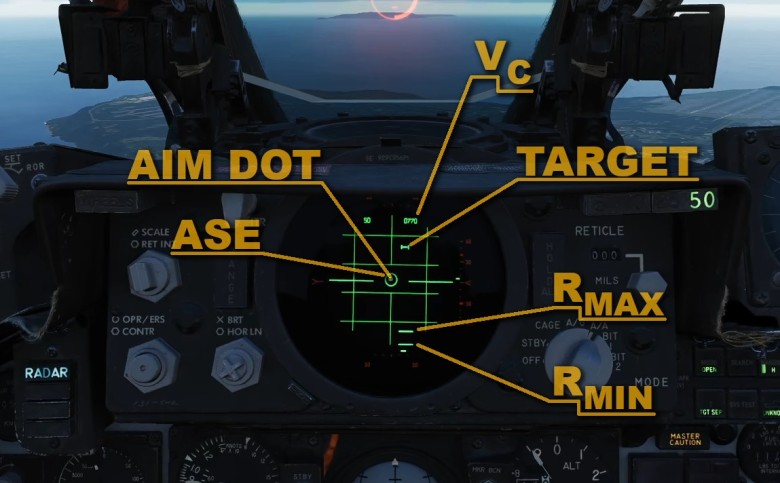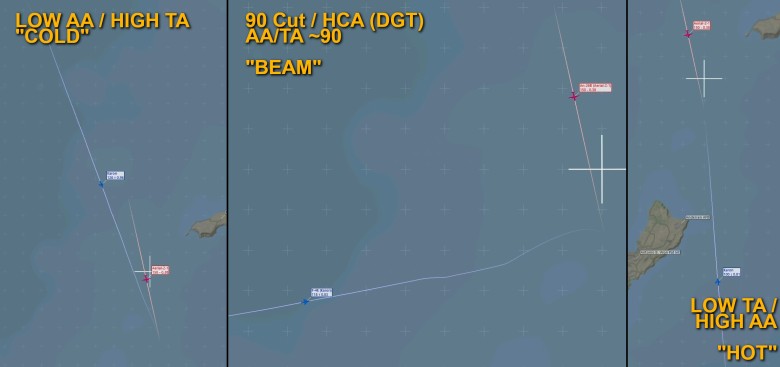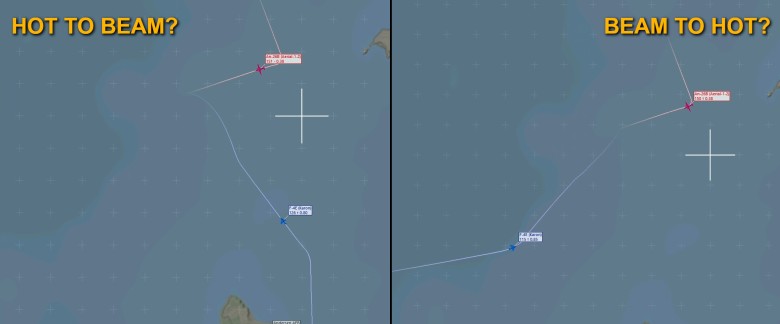Video
Rather than beginning the journey through the air-to-air employment of the Phantom II by unloading a wagon of theory, a task that the sixth chapter of the Phantom Phamiliarisation series has already taken care of, we start by discussing a neat application of the familiar Allowable Steering Error circle and dot – the aptly named “Aim-dot intercept”.
When the crew initiates a target lockon, the avionics switches to Single-Target Track. STT provides additional information about the target, such as aspect angle or heading, and continuously updates it. Depending on the weapon selected, the dedicated indications for maximum and minimum range (Rmax and Rmin) appear and are adjusted. The displayed circumference’s size, the ASE circle, changes as a function of the two mentioned ranges. The “Aim Dot” helps the crew to position the fighter correctly, and, for players familiar with the Tomcat, it works more or less as the F-14’s “T”. However, there’s more to it.
Follow the dot
To understand how the aim dot works, let’s consider three examples in which an F-4E is intercepting a “bogey spades” starting from different positions and following the dot until the “break X” is displayed.
On the right, high AA or low TA represent the Hot aspect. Low AA or high TA is the Cold aspect scenario on the left. The centre has a 90-right aspect, 90-cut, and Heading Cross Angle representing the Beam aspect.
In all cases, the AIM-7F Sparrow is selected.
As you can see, in the hot and cold cases, the Phantom guides the crew more or less straight towards the target, following the shortest route, ergo, collision course. However, in the beam aspect case, a stern conversion is initiated, resulting in the Phantom being in a good position for a short-range shot from the rear quarter or VID.
Although geometry appears to be the driving factor behind the aim dot indicated course, only one parameter is considered: range. This is evident when the geometry changes.
Aim Dot Logic
The aim-dot logic follows three stages:
- At longer ranges, collision steering.
- Transition steering starts at RMAX plus 2 nautical miles, then switches from collision to lead pursuit at RMAX.
- Inside RMAX, lead pursuit to increase missile efficiency.
However, there is a potential drawback. Since the aspect is not considered, this series of manoeuvres can result in superfluous stick-janking and worse geometry.
This example, the same one shown on the right, demonstrates how the aim dot cooled the geometry for a couple of miles, then prompted a turn to make it hotter, eventually leading to an unnecessary aspect increase.
Therefore, the crew can take advantage of the aim dot guidance, but they must also use their abilities and proficiency and intervene when necessary, depending on their objective.

Forcing the conversion
What if the crew wants to perform a stern conversion starting at a high aspect angle position? Other methods can be considered, of course, but otherwise, the crew should aim to manipulate the geometry, thus ideally moving from the “hot” scenario into the “beam.” For example, the WSO can call “Gate” to accelerate and “Crank” opposite the DoP or Direction of Passage to cool down the intercept and let the aspect decrease.
Vice versa is also achievable. Starting from hot, crank in the shortest direction (usually coherent with the DoP) and hold until the aspect decreases.

In the example shown, starting from circa 180 AA, I manoeuvred to place the targets close to the gimbal limits. The goal was eroding the aspect, gaining a few tens of degrees to “create room” and thus enabling the conversion. The aim-dot-driven manoeuvre did not produce a clean displacement turn plus counterturn but gave a good initial prompt to the crew but greater corrections in terms of speed and geometry may be needed.
As previously discussed, in fact, the aim-dot intercept goal is to assist missile employment, not generating enough room for a proper conversion.
If the crew evaluates the displacement or transition steering to be detrimental in that scenario, they can take over and approximate lead collision by turning half of the ATA in the opposite direction.
Alternatively, after the displacement, the crew can switch to pure pursuit to ease the counterturn. But this is a topic for another article.
Conclusions
The Aim-Dot intercept provides a quick-and-dirty means of intercepting a target without requiring any preparation besides the basic understanding of aspect and geometry.
The most significant drawback is the requirement of a lock-on since Track-While-Scan equivalents were not available in the APQ-120. On the other hand, the Aim-dot intercept can come in handy to ab initio virtual crews to improve the often inadequate pure pursuit, both when the goal is engaging a target or to rejoin wingmen or tankers.
Shout-out to the Japanese and South Korean communities!



